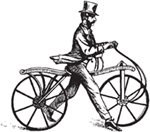
It took dozens of tries and more than a century—not to mention a lot of scraped knees and broken bones—to develop the bicycle. Here’s the story.
Humanity has had the wheel for thousands of years, but not until about 200 years ago were people able to use the wheel to get around without the aid of a horse or some other animal.
Exactly when and where the idea for the bicycle originated is unknown. Some historians claim that images of crude machines resembling bikes appeared on the walls of Egyptian tombs. Others argue that the ancient Romans had them in the city of Pompeii. There is even a drawing of a machine that resembles a modern bicycle in Codex Atlanticus, a collection of Leonardo da Vinci’s mechanical drawings from 1493, but whether or not Da Vinci drew it is heavily disputed (many argue it was forged by the monks who were restoring the drawings in the 1970s). So for all intents and purposes, the history of the bicycle doesn’t begin until very recently: the turn of the 19th century.
The first known bike was based on a toy. In 1790 in Versailles, France, the Comte Mede de Sivrac built an adult-sized version of a child’s hobbyhorse. He called it the velocifere, Latin for “fast” and “carry.” Judith Crown and Glenn Coleman describe it in their book No Hands:
It must have been a delightfully silly sight: two wood wheels joined by a stub of beam, saddled and shaped to resemble a horse, with de Sivrac running wildly astride it until the thing rolled fast enough to coast a few yards. Fashionable aristocrats soon were huffing across the royal gardens on their own velociferes—some machines outfitted as horses, others as lions or serpents—lifting their legs gleefully as they spun past amused pedestrians.
As much fun as the velocifere may have been, it was equally dangerous. It lacked two important features—steering and brakes. Riders and unsuspecting pedestrians were injured so often that the craze soon fizzled out and wouldn’t be tried again for almost 30 years.
Diet time: The Statue of Liberty weighs as much as 111,093 tacos.
A German man named Baron Karl von Drais de Saverbrun wasn’t fond of horses, finding them stubborn and moody, difficult to groom and saddle, and constantly leaving piles in their wake. Unfortunately, his job required that he ride one. He was the “master of forests,” a land surveyor for the wealthy duke of Baden’s very large estate. Von Drais needed some way to travel short distances without a horse.
In 1817, using the velocifere for inspiration, von Drais invented a new machine. It looked sort of like a modern bike but operated more like something out of the Flintstones: it had no pedals, so it required “foot power” to move it along. Von Drais’s machine was constructed entirely out of wood, weighed about 50 pounds, and was steered by handlebars connected to the front wheel. The rider leaned forward on a belly brace—a cushioned piece of wood that rested beneath the handlebars—and pushed off with his feet. By leaning forward, the rider could coast along at speeds of up to 10 mph. Von Drais called it the Laufsmachine, or “walking machine,” but most people referred to it as the draisienne.
Von Drais sold several of his machines to the French postal service. They were praised at first, but complaints of injuries soon started coming in. Although draisiennes rode well on the smooth fields that surrounded Duke of Baden’s property, they were no match for the potholes, hills, and harsh weather that the postal carriers often encountered—not to mention the fact that the rider’s feet were the closest thing the draisienne had to brakes. But despite its shortcomings, the draisienne got people excited about the possibilities of self-propelled machine travel.
Working around the same time as von Drais, an English coach maker named Denis Johnson came up with a better solution. He created the “hobby horse,” a version of the draisienne made out of wrought iron instead of wood. Like the draisienne, his machine lacked pedals, but the durable iron body was a vast improvement over wood and made for a much smoother ride. Johnson sold some “hobby horses” to wealthy Londoners, but creating them was so expensive, time consuming, and unprofitable that he soon stopped production.
More ships have been sunk by hurricanes than by warfare.
Sometimes necessity is the mother of invention; at other times, boredom is. In 1839 a Scottish blacksmith named Kirkpatrick MacMillan changed transportation forever when he decided to pass the hours of a slow day away by tinkering with an old “hobby horse.” He pondered the idea of attaching iron rods and foot pedals to the rear wheel. That way, he figured, riders could move the machine without having to push their feet against the ground. Rather, the rods and the pedals would crank the rear wheel and create motion, much like the locomotive, another recent invention. MacMillan built a prototype, gave it a ride, and lo and behold, it worked!
Being a natural showman, MacMillan amazed townspeople by riding his contraption at top speeds through the streets. But instead of being revered as a great invention, his new “hobby horse” was viewed as a dangerous menace. MacMillan could often be seen crashing into trees and flying over the handlebars. His escapades were put to an abrupt end when he was arrested for knocking down a small child in 1842 (the first known cyclist-related offense).
Although he never really marketed his invention and died before it caught on with the masses, many regard MacMillan as the father of the modern bicycle. A plaque is displayed at the site of his blacksmith shop which reads: “Kirkpatrick MacMillan: He builded better than he knew.”
Round and round and round she goes. For Part II of the story, just follow your nose…to page 286.

What makes Calvin Coolidge unique? He was the only president born on the Fourth of July.